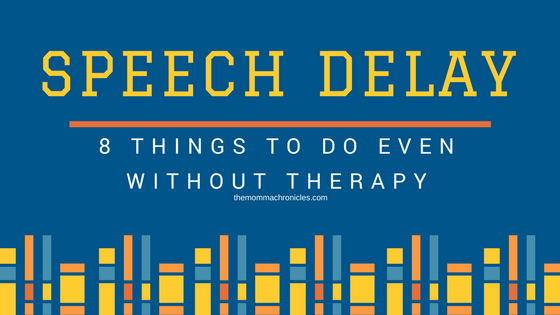According to Baby Center, a baby learns to talk during the first two years of his/her life. It starts with the simple “oohhh” and “ahhh” and starts to babble by three months. By six months, a baby can say “mama” or “dada,” although not necessarily referring to you (admit it, it brought tears to yours eyes). Eventually, your child can say one or to words and by the time s/he reaches two, s/he has more than 50 words in the vocabulary and can make simple phrases.
Let me tell you something: my youngest daughter didn’t talk much until she was two and yes, this made me worry. She rarely say “mommy” or “daddy” and doesn’t use words to tell us what she wants. All she did was to whine or cry every time she wants something. Nonetheless, I was told by their pediatrician that there is nothing to worry – yet – but by the time she turns two, she must be able to say at least 50 words.
Well, she did and more, but for me, that wasn’t enough. I wasn’t getting response or conversation you would expect from a two to three-year old. It was isang tanong, isang sagot, so my husband and I decided to pay extra attention to her – and here’s what we did:
1) Start with creating requests.
I read somewhere that to encourage a child to talk, one must initiate the child to make a request, so we did. Our youngest is fond of anything kitchen-related toys, enjoys cutting foods, and pretends to cook. The next time she wanted to play, we asked her what she wants, sometimes giving her cues until the words come out naturally. Now, she can say, “Mommy, I want to play with fruits” or make requests on her own, which is good.
To initiate request, it is best to start with using something a child loves – a favorite toy, favorite food, or a favorite activity. You can also try this pattern:
- Complete the verbal cues: “I want the pink doll,” then encourage your child to say the complete sentence.
- Fill in the blanks: “I want ______” then your child should say what s/he wants.
- Physical prompts: Point at the object until your child says it on his/her own.
2) Encourage answering in “Yes” and “No.”  Aside from creating requests, mastering “yes” and “no” is another thing we did to encourage our daughter to talk. We started with showing things she didn’t like since apparently, it is easier for kids to say “no” instead of “yes.” After showing at least three things she didn’t like, we followed it up with an object she likes then asked her to say “yes.”
Aside from creating requests, mastering “yes” and “no” is another thing we did to encourage our daughter to talk. We started with showing things she didn’t like since apparently, it is easier for kids to say “no” instead of “yes.” After showing at least three things she didn’t like, we followed it up with an object she likes then asked her to say “yes.”
To master “yes” and “no,” start with showing objects your child doesn’t like before giving him/her an object s/he likes. To do this as much as you can until your child can say it naturally.
3) Make commands.
We wanted to make sure that our daughter can understand what we are saying. To do this, we always make commands to test her comprehension. We started with simple commands like “Can you give me the red apple” or “Can you close the door?” which she immediately followed.
Once she was able to process simple commands, we incorporated the word “and” to increase the demand. We did this by using her favorite kitchen toys first and asked her to give us two things at the same time (Can you give me apples and oranges?).
Initially, our daughter gave us apple or orange, so we had to point at the two objects to make her understand that we want apple and orange. She learned the concept of and eventually through constant practice.
4) Introduce verbs / action words.
This is how my daughter used to talk: “Mommy, I want bubbles” or “Mommy, I want to car.” Verbs and action words are often missing in her vocabulary, so we decided to focus on that. We started by showing her flashcards and asked her what the person is doing. If she is not familiar with a particular picture, we tell her (running, sleeping, eating, writing, etc.).
As soon as she is familiar with the word, we asked her again and this time, made her say it in a complete sentence (“The girl is sleeping” or “The boy is eating”). Eventually, she was able to answer us in complete sentence when we ask her what the person is doing.
Tip: Incorporate the exercise in everyday life. Words will come out naturally through constant practice.
5) Say YES to pretend play.
I am careful when choosing toys for my kids. As much as possible, I want their toys to be educational and interactive because I want to encourage pretend play. Aside from boosting the kids’ imagination, pretend play also helped my youngest daughter improve her speech capabilities. It started with incorporating the sentences or phrases from the shows she watch and eventually, she can create her own stories and lines.
6) Sing songs.  All the time. We often watch Youtube videos and play Disney songs for her to sing and memorize. The surprising part was she was able to pick up the words and phrases and use it in appropriate situations.
All the time. We often watch Youtube videos and play Disney songs for her to sing and memorize. The surprising part was she was able to pick up the words and phrases and use it in appropriate situations.
7) Repetition is key.
Admit it. You were able to memorize whatever you need to memorize through repetition. Same goes with kids. It is normal for kids not to get it the first time. I’ve seen it in my daughter. Through repetition, words came out naturally whenever the situation calls for it.
8) Pay attention and talk to your child. A LOT.
My husband and I were guilty of this. We paid too much attention on our eldest (academic-wise) since we want to prepare her for big school. It wasn’t intentional, but we paid less attention to our youngest (no parent-shaming please!). Of course, we realized our mistake and made up for it. We gave equal attention to our kids and we saw a big difference. She started speaking up and more. She was more expressive, responsive, and talkative compared to few months ago. 
There is still a slight delay on my daughter’s speech abilities, but we’re glad that she improved a lot. She’ll be going to school this school year and I was told that it will help a lot to boost her speech since she will be around lots of people. Nonetheless, these tricks were a good start.
Note: I am neither a Speech Pathologist nor a parenting expert. All of the tips outlines were based on personal experiences. If you think your child is experiencing speech delay despite trying out these tips, it is highly recommended that you seek opinion from a Developmental Pediatrician or Speech Pathologist for further diagnosis.

Ayi is a stay-at-home mom of two. When her kids are in their best state, she keeps up with chores, work, and ensuring that her sanity is intact. Join her as she navigates through this rollercoaster ride called motherhood.
















I had the same dilemma when my son was two years old. I even scheduled an appointment to DevPed but two appointments were cancelled by the doctor (something came up). I didn’t reschedule the appointment na baka kasi hindi ko naman need ipacheck talaga at paranoid lang ko. I stopped my part time job (ghost writer) so I can pay attention to my son. Naguilty din ako nun kasi busy ko sa kakatapos ng deadlines then wala kausap anak ko. He started to increase his vocabulary when he started to attend school. 🙂
My daughter is going to school now and thankfully, after a week, her speech has improved a lot. What more can a year do diba? Yes, I was paranoid din, but I just want to make sure that she’ll be alright 🙂
These are good tips, especially the #7. It helps our kids develop their skills if we listen and talk to them a lot of times. This also helps them develop confidence.
None of my three kids had speech delay. I don’t know with our new baby though. He’s only 9 months old and keeps babbling a lot. Looking forward to him saying his first actual word. In case we experience speech delay with him though, I’ll be sure to try out your tips. 🙂
This is truly helpful. I have a 22 months old son and though he speaks, he doesnt fluently. He would often say anything we cant understand and often, my mom would worry. I would do these techniques especially the easy yes and bo answers. Noted as well on the complete sentence structure. I am.also excited to hear my son say so many things. I find him too talkative even if I cant understand his language at times. Ihihi.
That’s a good sign 🙂 Atleast talkative. Mine kasi wala talaga before, then biglang nagboost yung speech niya :))
Very helpful. The key is really to be there for our kids. To be observant of their response and behavior and apply these tips according to their needs. I also had to do extra effort with my second son, he’s not that delayed but a little ‘bulol’ at times so I had to take time it teaching him the right way to say the word. It wasn’t easy, but it paid off. Instead of waiting for kids to go to school to be corrected, we as first hand care and love givers should really take time in helping them. This is a very helpful post. I’ll be trying the other tips as well. =)
Agree that as parents we need to spend a lot of time with the kids when they are young to help encourage and help develop their speech and vocabulary so that they will be able to communicate with everyone as they grow up.
This is very helpful! My 3yo son can say words na but not a complete sentence. He is also good in imitating what I am saying. He can follow instructions too like turning on/off the lights and packing away his toys. He is so madaldal and I can’t wait to hear him talk clearly na lols.